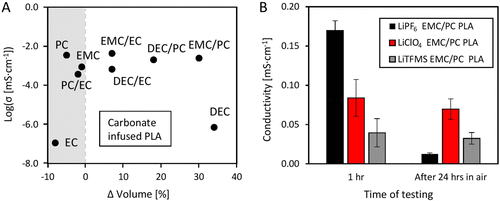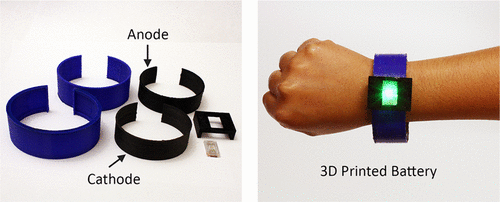Researchers Explore 3D Printing Embedded PLA Batteries Using Fused Deposition Modeling
We rely on many different types of energy sources to get through the day for our mobile power needs, making batteries a big industry. Researchers are continuing to look for ways to refine them for more streamlined use, however.
In ‘Three-Dimensional Printing of a Complete Lithium Ion Battery with Fused Filament Fabrication,’ US researchers explore ways to customize these smaller sources of energy, plus building them into components. They point out that much work has been done previously with batteries, featuring everything from spray paintable batteries to stretchable batteries. In connection with 3D printing, researchers have experimented with fabricating ink-printed electrodes, as well as those fabricated with graphene. The goal is to remove the current limits caused by conventional shapes.
“Although there have been many recent advances in the creation of unconventional battery form factors, most prototype fabrication methods are limited to curved or flat surfaces,” states the team in their paper.
In exploring 3D printing with electronics, the team points out that this is an area making enormous strides, but the batteries are still always a separate quotient. The key is in printing everything at once—including all the following for the battery:
- Anode
- Cathode
- Separator
- Current collector
- Battery case
With the use of a low-cost FFF 3D printer and PLA as a material, the researchers measured the amount of swelling caused in the PLA by the nine solvents they used, along with the rising levels of conductive power, the amount of improvement and retention in PLA conductivity after lithium infusion, and they examined the effects of conductive carbon filler on performance.
“We hypothesized that PLA could be converted into an ionically conducting matrix by swelling the polymer with liquid electrolytes, thereby enabling the 3D printing of a lithium ion battery,” stated the researchers.

(A) Log ionic conductivity versus percent volume change for PLA infused with various carbonate solvents. (B) Ionic conductivity of PLA infused with lithium salts after storage in air.
They were able to increase the conductivity of the material significantly and were able to fabricate batteries that withstood 100 cycles but showed a low capacity because of the large amounts of PLA required.
“Nevertheless, we used these new composite filaments to demonstrate that a full 3D printed LIB can be made in a single print with no assembly required, and that integrated 3D printed batteries can be used to power electronic devices such as 3D printed LCD sunglasses and an LED bangle,” state the researchers.
The team figured out how much conductive filler they could add to the PLA for creating successful battery power and found that performance increased as ‘the ratio of active to conductive material decreased.’
They created a 3D printed full cell with all components inside the coin cell:
“All printed anodes, cathodes, and separators were 16 mm in diameter and 150 μm thick, and were infused with 1 M LiClO4 in 50/50 vol EMC/PLA prior to assembly. Electrifi filament was used for 3D printing the current collectors, as it has the highest conductivity of all commercially available conductive filaments. Pure PLA was used for printing the separators.”
The team also printed two different wearable devices with built-in batteries—a pair of glasses, and a bracelet, demonstrating that it is feasible to create functional objects that run on stable power.
“These results should benefit those seeking to create energy storage materials and devices that can be 3D printed to create batteries in arbitrary shapes,” concluded researchers.
What do you think of this news? Let us know your thoughts! Join the discussion of this and other 3D printing topics at 3DPrintBoard.com.
[Source / Images: Applied Energy Materials]
(A) graphene, (B) multiwalled carbon nanotubes (MWNTs), and (C) Super P. (D) The resistivity versus volume percent of Super P, graphene, and MWNTs loaded into PLA. The maximum volume % that was also printable is labeled for each material. (E, F) Average capacity versus ratio of conductive carbon to active material in PLA for the anode and cathode, respectively.

(A) Individual components of the 3D printed coin cell. (B) Assembled 3D printed coin cell. (C) Capacity and Coulombic efficiency at a current density of 20 mA g–1 for 100 cycles. (D) Charge–discharge voltage curves for the full-cell with 1st, 10th, 50th, and 100th cycle shown.
Subscribe to Our Email Newsletter
Stay up-to-date on all the latest news from the 3D printing industry and receive information and offers from third party vendors.
Print Services
You May Also Like
New Business: Temporary, Migratory, & Modular 3D Printed Architecture
If we look at potentially emerging 3D printing businesses, then architecture has not been fully explored. Yes, there is a lot of house 3D printing going on worldwide. From deployable...
3D Printing News Briefs, April 19, 2025: Material Extrusion Standard, Metal Powder, & More
In today’s 3D Printing News Briefs, we’re covering a proposed standard for material extrusion, before moving on to business and metal powder. We’ll end with a commercial store’s robotic 3D...
Japan Unveils World’s First 3D Printed Train Station
Japan is now home to what we believe is the world’s first train station built with 3D printing technology. Located in Arida City, just south of Osaka, the new Hatsushima...
restor3d Raises $38M to Expand 3D Printed Orthopedic Implants
Backed by $38 million in new funding, restor3d is pushing ahead with the launch of four personalized implant lines, set to roll out in 2025 and 2026. This latest venture...


























